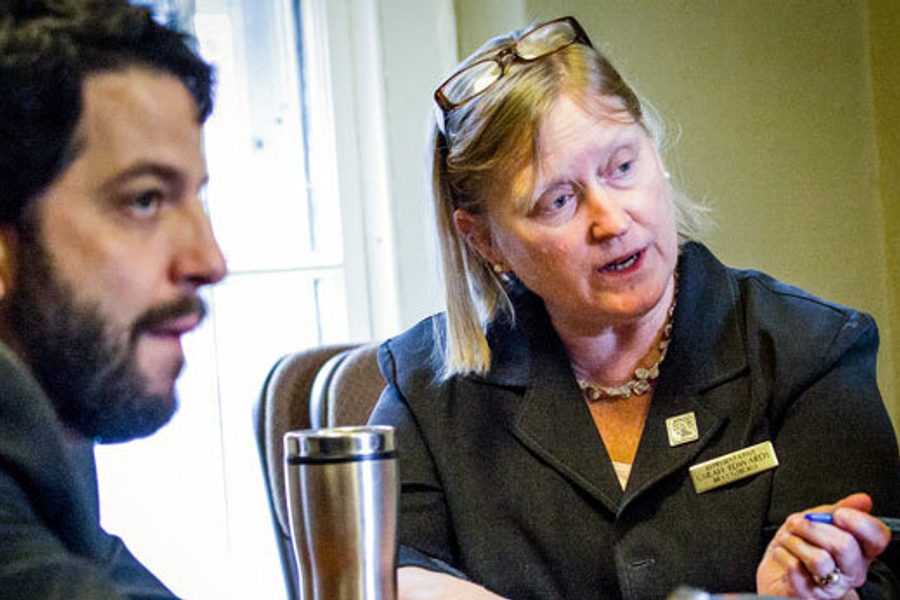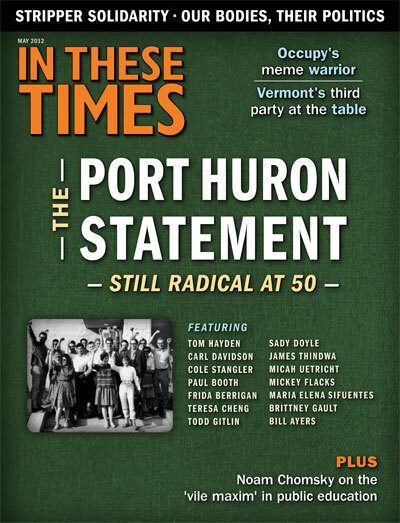Out of the Margins, Into the Fray
The Vermont Progressive Party wields outsized influence on state politics.
Steve Early

In this presidential election year, millions of voters find themselves caught, once again, between a Republican rock and a Democratic hard place. Because of the primacy of the two-party system, only major party candidates have the funding, organization and media visibility to be competitive in most federal, state and local elections. As a result, Greens or other minor party standard bearers are almost never elected to public office. (A hundred years ago, things were different when thousands of Socialists successfully ran for municipal office.)
One state where left-leaning voters do have greater choice today – and their own political voice – is Vermont. Thanks to several decades of persistent organizing, the Vermont Progressive Party (VPP) now boasts seven members in the legislature – two senators (out of 30) and five representatives (out of 150) in the House (some of whom affiliate with the Democratic Party as well). Since Vermonters sent the first “Prog” to Montpelier in 1990, 16 have served a total of 48 legislative terms in the state capitol. Progressives have introduced legislation, served on key committees and played a catalytic role in public policy formation.
Despite the VPP’s recent loss of Burlington City Hall, where a Democrat was just elected mayor for the first time since the late 1970s, the party retains three city council seats (out of 14) in Vermont’s largest municipality. Over the years, more than 29 VPP members have served as part of the Progressive bloc on the council. One newly-elected member is Burlington Department of Public Works commissioner Max Tracy, a 25-year-old former student activist at the University of Vermont, long involved in organizing campus workers. He won in the city’s Old North End section by campaigning for living wage jobs, affordable housing, a sustainable transportation system and support for local farmers and gardeners.
In similar fashion, Progressives running in nonpartisan races in small towns serve on local school committees, select boards and community planning bodies. Plus, they turn out on Town Meeting Day to help pass resolutions in favor of issues like tax reform and overturning the Supreme Court’s pro-corporate decision in Citizens United – both the subject of town meeting action in 70 Vermont communities in March. While never formally aligned with the party himself, Vermont’s socialist U.S. senator, Bernie Sanders, has backed some VPP candidates for state and local office, while VPP activists have, in turn, been his most ardent supporters in past statewide races.
Taking a leaf from Sanders’ singular 30-year career – as Burlington mayor, then Vermont’s lone congressman, and now junior senator, the Progressives have distinguished themselves from their Democratic competitors by focusing, in populist fashion, on economic issues. In areas of the state where working-class voters might otherwise be swayed by cultural conservatism or residual rural Republicanism, the VPP has, like Sanders, won elections by campaigning for labor rights, fair taxes and single-payer healthcare far more consistently than the Democrats. The party’s statement of principles has a distinct tinge of Occupy. “Democracy,” it declares, “requires empowering people not only in government but also in the workplace, schools, and in the overall economy. Society’s wealth should not be concentrated in the hands of a few, and a wealthy minority should not control the conditions under which we live.”
Healthy competition
One measure of the Progressive impact on public policy is the preliminary steps that Vermont took last year to create a first-in-the-nation single-payer healthcare system – though this achievement may still be thwarted, due to business opposition during a complicated multi-year implementation process or any intervening loss of Democratic Party control over the legislature or governor’s office.
In coordination with a strong grassroots movement, both Sanders and the VPP continued to make single-payer a central political issue, keeping the pressure on local Democrats. Current Gov. Peter Shumlin’s previous bid for statewide office – a run for lieutenant governor in 2002 – ended in defeat when Progressive Anthony Pollina, a strong single-payer advocate and now a state senator, received 25 percent of the vote.
Determined to avoid that fate again, Shumlin, a millionaire businessman and former Senate president, tacked left on healthcare reform in the 2010 Democratic gubernatorial primary and the general election. He narrowly won the five-way primary and then, with no Prog in the race, defeated Republican Brian Dubie by a 2-percent margin after getting much-needed help from Sanders with last-minute working-class voter turnout. With a Democratic-Progressive majority in both houses of the legislature, Shumlin followed through on his campaign pledge to introduce a single-payer plan and make its passage a top priority of his administration last year.
“We have a homeopathic role in the Vermont body politic,” says Ellen David-Friedman, a former organizer for the Vermont-National Education Association (NEA) and longtime Progressive Party activist. “We’ve managed to create enough of an electoral pole outside of the Democrats to constantly pull them to the left on policy issues, by dispensing an alternative brand of medicine that’s become increasingly popular.”
To maintain its “major party” status under Vermont law, the VPP must field a candidate every two years who garners at least 5 percent of the statewide vote. Progressives rarely perform better in statewide races than Martha Abbott, a tax accountant from Underhill, who received 12 percent in her 2008 campaign for state auditor. To boost its win rate, the party has lately focused on recruiting and supporting viable contenders for legislative seats. “Our strategy of both challenging and working with Democrats … makes us somewhat unique,” says Abbott, who was re-elected VPP chair at a lively party conference in Montpelier in November 2011.
Small is beautiful
With a population of 626,000 people, Vermont has electoral constituencies small enough for people with progressive ideas to canvass door-to-door, meet nearly every voter and drum up enough campaign contributions to be competitive. House member Chris Pearson, who specializes in tax and budget issues for the VPP, represents one of the state’s larger multi-seat districts; he only had to raise $12,000 for his last election campaign.
Some VPP legislative candidates have, like Pollina, campaigned with the “D/P” label – a form of de facto cross endorsement achieved after running successfully in a Democratic primary. (Six of the seven Progs in the state legislature are D/Ps.) Where possible, other Progressives have also sought Sanders-like accommodations with Democrats in races where a strong general election showing by two left-of-center candidates would guarantee Republican victory. Several VPP legislators, including state Rep. Susan Hatch Davis, actually represent districts where their main competition comes from GOP nominees; local Democrats are, in effect, the “third party.”
The VPP’s politically savvy and flexible approach has helped it struggle against what Executive Director Morgan Daybell calls “the negative perception of third parties in general.” In contrast, local Greens and what’s left of the Liberty Union Party in Vermont – Bernie Sanders’ original political home in the 1970s – have not suffered the fate of most left-wing parties elsewhere (i.e. being presentable but marginal at best, ideologically pure, or just plain eccentric, with little to show, organizationally, for any single-digit share of the vote they garner).
The Progressive Caucus at work
On a recent visit to Montpelier I found Pollina making his presence felt under the gilded dome of the state capitol building. A longtime advocate for farmers, tax justice and campaign finance reform, Pollina joined Sen. Tim Ashe (D/P) in the state Senate two years ago. In the current legislative session, Pollina has been promoting the idea of a state bank, a bill requiring Vermont to “hire and buy local” (when contracting for state services) and a budget-related survey of poverty and income inequality.
Elsewhere in the same building, Rep. Pearson huddled with Reps. Mollie Burke and Sarah Edwards at the weekly meeting where VPP members of the House gather to share information and coordinate legislative strategy. Burke and Edwards are both from the Brattleboro area and are engaged with environmental and public health issues related to decommissioning the Vermont Yankee nuclear power plant in their corner of the state.
On this particular mid-March day, Vermont unions, strongly supported by the VPP, were working to overcome Democratic reluctance to grant collective bargaining rights to publicly-funded “early childhood educators” who provide home day care. Hoping to win further organizational endorsements, donations and support – from the American Federation of Teachers (AFT), the Vermont-NEA and Vermont State Employees Association (VSEA) unions, along with the AFL-CIO – the VPP has strongly supported the AFT’s child-care organizing campaign. Progressives have also defended VSEA members against public criticism by Gov. Shumlin during a dispute about state worker contract enforcement last year.
In White River Junction and other communities, Windsor County Party Chair Liz Blum and several elected local VPP officials are now working with the Vermont Workers Center and local Occupy activists to fight contraction of the U.S. Postal Service, which would eliminate several hundred union jobs and adversely affect mail delivery in the state.
As Blum explains, these “cuts would be devastating for elderly, rural and low-income Vermonters who depend on the reliability and affordability of the mail, and for whom the post office functions as a social link. It’s often the place where people interact with neighbors, petition for ballot measures and swap news, the kind of space that’s made small-town Vermont so famously democratic.” Such nonelectoral activity on behalf of a key labor and community cause barely registers on the radar screen of Vermont Democrats.
Vermont State Labor Council Secretary-Treasurer Traven Leyshon, who also serves on the VPP’s state coordinating committee, says, “Local labor leaders are now willing to support Progressive candidates over Democrats – when they’re credible – because of such pro-labor stances.” In some cases, he said, rank-and-filers have had to overrule the safer, more conservative candidate endorsements favored by their own union lobbyists and political directors.
This small insurgency from below, in Vermont’s public sector-oriented labor movement, mirrors the VPP’s own trajectory in state politics. In a fashion that one hopes will not be the exception, Progressives have moved from the margins to Montpelier, from also-ran status to an influential role in state and local government. If there were more Left partying like that in other states, at least one of the two major parties might feel greater pressure to behave better.
Steve Early was involved in organizing, bargaining, and strikes at AT&T and Verizon for 27 years, while serving as a Boston-based CWA International representative and, later, administrative assistant to the vice-president of CWA District 1, the union’s largest. He is an active member of the NewsGuild/CWA Freelancers Unit in the Bay Area and is supporting Sara Steffens for CWA president. He has written five books about labor or politics and can be reached at Lsupport@aol.com








